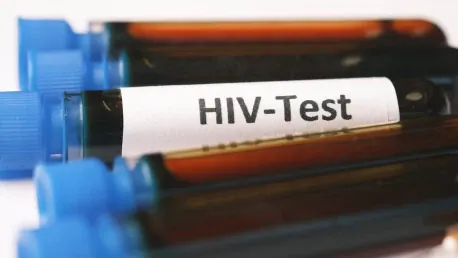The International Antiviral (formerly AIDS) Society-USA (IAS-USA) has unveiled comprehensive international guidelines for the treatment and prevention of HIV, coinciding with the observance of World AIDS Day on December 1, 2024. These guidelines were meticulously developed by a panel of volunteer medical experts, among whom are noted professionals like Prof. Clara Lehmann of the University Hospital Cologne and the German Center for Infection Research (DZIF). They are informed by the latest advancements in antiretroviral therapies and new prevention strategies such as pre-exposure prophylaxis (PrEP).
Progress in Antiretroviral Therapy
Advancements in Personalized Treatment
One of the key themes highlighted in the guidelines is the significant progress made in antiretroviral therapy. Now, many individuals living with HIV can achieve a normal or near-normal life expectancy, thanks to these advancements. Tailored antiretroviral therapy is increasingly emphasized, especially for patients who cannot tolerate specific HIV drugs. The emergence of long-acting injectable therapies has been acknowledged as a valuable tool for ensuring adherence to treatment, as these injectables reduce the burden of daily medication intake and consequently improve patient compliance.
The panel’s review process was comprehensive, involving an extensive examination of peer-reviewed literature and conference presentations from June 2022 to October 2024. This review also incorporated data from antiretroviral manufacturers to provide well-rounded recommendations. The goal is to update the guidelines regularly to reflect ongoing developments, thereby ensuring optimal patient care. These guidelines not only recommend the most effective drug regimens but also stress the importance of considering individual patient needs and circumstances, thus promoting a personalized approach to treatment.
New Long-Acting Injectable Therapies
In recent years, the advent of long-acting injectable therapies has brought a revolutionary change to HIV treatment. These therapies offer a significant benefit, particularly for patients who struggle with the daily regimen of oral medications. Long-acting injectables, administered monthly or even bimonthly, have shown promising results in clinical trials, demonstrating high efficacy and improved adherence rates. This innovation allows individuals to maintain stable antiretroviral coverage without the daily reminder of living with HIV, thereby enhancing their quality of life.
Furthermore, the guidelines emphasize that these injectable therapies should be made available to a broader range of patients. This includes those who have had difficulty adhering to daily oral treatments, those who experience side effects from specific medications, and those who simply prefer the convenience of less frequent dosing. By expanding access to these long-acting options, the guidelines aim to improve overall treatment outcomes and support the diverse needs of the HIV-positive population.
Emphasis on HIV Prevention Strategies
Enhancing Pre-Exposure Prophylaxis (PrEP)
Another significant focus of the updated guidelines is the emphasis on HIV prevention through strategies like pre-exposure prophylaxis. PrEP is recommended for individuals at heightened risk of HIV infection, and the guidelines highlight its availability in different forms, including daily oral medication and long-acting injectables. This advancement offers more flexibility and convenience for those opting for preventive measures, thereby encouraging consistent usage and greater protection against HIV.
PrEP has been shown to be highly effective in preventing HIV transmission when taken as prescribed. The guidelines underscore the importance of making PrEP accessible to all at-risk populations, which involves addressing barriers such as cost, stigma, and lack of awareness. They suggest initiatives such as community outreach, education campaigns, and integrating PrEP services into routine healthcare visits to bolster uptake and adherence. This holistic approach aims to significantly reduce new HIV infections and is a key component in the strategy to end the HIV epidemic.
Post-Exposure Prophylaxis and Doxycycline Use
The guidelines also highlight the importance of post-exposure prophylaxis (PEP) in preventing sexually transmitted infections (STIs). Doxycycline, an antibiotic, has been affirmed as an effective post-exposure prophylaxis for preventing bacterial STIs. This recommendation is based on recent studies that demonstrate its efficacy in reducing the incidence of infections such as syphilis and chlamydia among high-risk populations. The inclusion of doxycycline in the prevention toolkit represents a significant step forward in comprehensive sexual health strategies.
The implementation of PEP, particularly doxycycline, necessitates coordinated efforts between healthcare providers, public health officials, and community organizations. Educating at-risk individuals about the availability and proper use of PEP can greatly enhance its effectiveness as a preventive measure. Moreover, integrating PEP into existing sexual health services ensures a more comprehensive approach to STI prevention, addressing not just HIV but a broader spectrum of infectious diseases. The guidelines call for innovative approaches to disseminate PEP information and streamline its accessibility to those who need it most.
Holistic Approach to HIV Care
Comprehensive Patient Care Strategies
Beyond treatment and prevention, the updated guidelines from IAS-USA emphasize a holistic approach to HIV care. This encompasses addressing the prevention of cardiovascular diseases, managing substance use disorders, and monitoring weight changes that may occur during antiretroviral therapy. Patients living with HIV often face a multitude of health challenges, and these guidelines advocate for an integrated care model that addresses both HIV-related and non-HIV-related health issues to improve overall patient outcomes.
Cardiovascular disease prevention is particularly pertinent, given the increased risk of heart-related issues among people living with HIV. The guidelines recommend regular monitoring of cardiovascular health, promoting a healthy lifestyle, and considering potential interactions between HIV medications and treatments for other conditions. Additionally, the management of substance use disorders is crucial, as these can significantly impact treatment adherence and overall health. The guidelines advocate for accessible support services and interventions to address these challenges comprehensively.
Bridging Gaps in Care Access
Addressing disparities in care access is another crucial aspect of the guidelines. The guidelines recommend targeted solutions for underserved communities to ensure equitable access to life-saving interventions. Strategies include expanding telemedicine services, deploying mobile health units, and utilizing smartphone reminders for medication adherence. Traditional support methods like pill boxes and regular check-ins also play a vital role in ensuring that no one is left behind.
These efforts are particularly important in reaching populations that may face barriers to healthcare access, such as those in rural areas, low-income communities, or individuals experiencing housing instability. By leveraging technology and innovative care models, these guidelines aim to bridge gaps in care and enhance the reach of HIV prevention and treatment services. In doing so, they contribute to the broader goal of ending the HIV epidemic and ensuring that all individuals have the opportunity to achieve and maintain optimal health.
Conclusion and Future Directions
The International Antiviral Society-USA (IAS-USA), previously known as the AIDS Society-USA, has released extensive global guidelines for HIV treatment and prevention. This announcement is timed with World AIDS Day on December 1, 2024, emphasizing a significant milestone in the fight against HIV. The guidelines were carefully crafted by a team of volunteer medical experts, including distinguished professionals such as Prof. Clara Lehmann from the University Hospital Cologne and the German Center for Infection Research (DZIF). These new guidelines incorporate the latest developments in antiretroviral therapies and innovative prevention methods, notably pre-exposure prophylaxis (PrEP). The IAS-USA aims to provide healthcare professionals worldwide with updated, evidence-based strategies to manage and prevent HIV more effectively. By integrating the most recent scientific findings and clinical expertise, these guidelines serve as a comprehensive resource for improving patient outcomes and advancing global public health initiatives in the ongoing battle against HIV.









